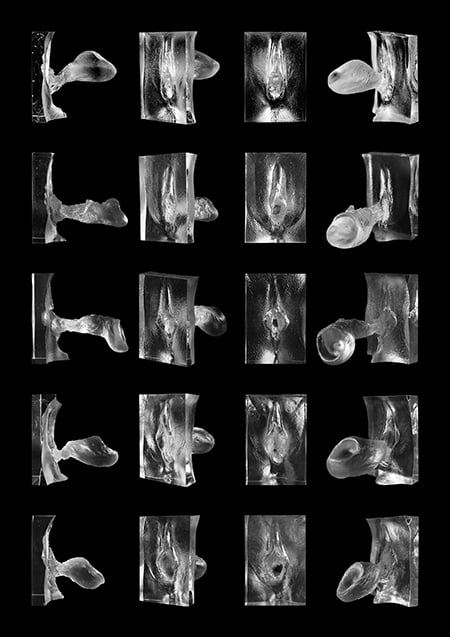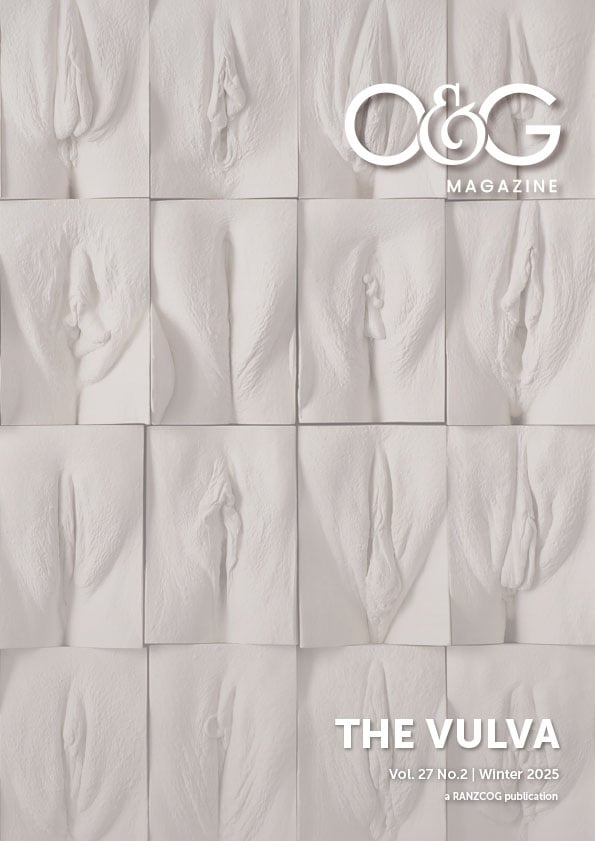The cover of this special ‘Vulva’ edition of O&G Magazine features a panel from British artist Jamie McCartney’s internationally acclaimed work, The Great Wall of Vulva. Spanning eight metres and featuring over 400 plaster casts, the installation challenges narrow ideals of beauty and celebrates the natural diversity of the vulva. In this interview, McCartney reflects on the inspiration behind the project and the impact it has had on participants and viewers alike.
Can you share a bit about your journey as an artist? What first drew you into art, and how did those early experiences shape your practice?
My mother is a painter, and I grew up in London with all its rich international history and culture. I always knew I would be an artist – making things was my happy place. I remember seeing Salvador Dali’s “Lobster Telephone” as a child; it spoke to me, it was unconventional and absurd, and it showed me that anything can be art. Much of my work now defies convention, using real objects to make statements or tell stories, so that artwork remains a big influence.
I went on to complete a bachelor’s degree in Experimental Art and I chose to study in the USA, as it offered me the progressive education I was craving. My education was steeped in social politics, and it still greatly informs my practice today. I have no interest in making stuff that looks like something you’ve seen before so experimenting is critical to keep punching the envelope.
What inspired you to create The Great Wall of Vulva?
In 2006, I was commissioned to create a piece for a sex museum and made The Spice of Life – a wall of genital and breast casts from 18 men and 18 women. Including my own cast allowed me, for the first time, to compare myself to others without the distortion of pornography. It was surprisingly affirming. Conversely, many women expressed dissatisfaction with their labia, pointing out previous casts with smaller labia as more desirable. Other women were reassured by seeing larger labia that mirrored their own.
At the time, labiaplasty was the fastest growing surgery in the UK, and I thought “No! Not in my name.” I don’t stand for the idea that smaller labia are ‘better’, and I don’t believe women are defective or in need of fixing. Since this was a psychological issue, not a physical one, surgery seemed an excessive response. I’m not opposed to surgery when it’s an informed, autonomous choice, but too often, women make decisions without ever seeing what vulva diversity looks like. That’s what The Wall offers, representation and reassurance.

‘The Great Wall of Vulva’ © Jamie McCartney. All Rights Reserved, DACS/Copyright Agency, 2025
Why did you choose plaster casting as your medium?
Plaster casting was at the heart of the project from the very beginning. I did consider using photography early on, but I felt it would never escape the similarity with porn. Casts of a modular size would be an honest, almost scientific survey. I chose plaster partly because the uniformity of the white casts would neatly sidestep any indication of skin colour. But mainly I used plaster because it was cheap, and this project was completely self-funded.
Were there particular ethical responsibilities you felt when working with participants?
Yes, it was a terrifying prospect when I started. I didn’t want to get anything wrong or risk devaluing the project by any sense of it being erotic art. I’d had no training in how to do this so I developed a protocol that was there to provide safety to all concerned and to ensure my models were clear in what they were signing up for and what would happen on the day. It was important to me that they were volunteers as that clearly indicates their endorsement and belief in the project. A man paying women to take their clothes off would have conveyed a totally different message.
I honoured their trust by designing the piece to be deliberately architectural, sterile and unerotic. The repetitive tiling of hundreds of casts meant you don’t focus on and fetishise any one vulva. The eight-metre-long linear array means you have to be in motion to see the whole piece. It’s a very active viewing experience and I think it really prevents it from being in any way a sexual experience.
Can you share a memorable story from a participant or viewer?
There are hundreds, which is why I created a book alongside the artwork to share them. Many participants spoke of the healing experience, of reclaiming their bodies after trauma, overcoming anxiety, or simply doing it in solidarity to help other women or to get over their own genital anxiety.
During the private show I did for the participants, they all were trying to find their own cast, enlisting partners to participate in the search. Some went to the loo to take photos of their vulvas on their phones to use as a guide and even swapped phones with other women to help the search. It was hilarious theatre.
Viewers similarly express a huge range of feelings. I have seen several women leave the exhibition crying.
Do you feel society’s understanding of vulva diversity has improved since you began the project?
It’s hard for me to be objective about what has changed and what impact my work may have had. Anecdotally, I believe the conversation has moved on. I receive a lot of positive feedback from both the public and professionals. The comments page on my website alone tells me this work has been a game-changer.
Looking at social media, there is now far more open discussion about labia, vulvas, and menstruation, and I do think society is less shy about these topics. By creating The Great Wall of Vulva website, I provided a free online resource for women and men around the world to find the answers they are looking for, it still amazes me that it took an artist to do that.
However, challenges remain. Misogyny and body shaming persist, especially among disaffected youth drawn into harmful online cultures. Education remains critical. We need to meet young people where they are – on social media platforms – and fight disinformation with real information.
Have you received feedback from healthcare professionals, and what role do you think they can play in normalising genital diversity?
Yes, I receive continual positive feedback from healthcare professionals. Images of the work are widely used to reassure women and girls, where photos of actual vulvas may be inappropriate. The plaster casts have a more clinical feeling. It is also used by surgeons performing gender affirming surgery on trans patients, to manage expectations around outcomes. Its value cannot be underestimated.
I think doctors are critical to shifting attitudes. They’re in a position of immense trust. I often say: there should be a panel from The Great Wall of Vulva in every doctor’s surgery! Visual education could make a profound difference in tackling genital insecurity early.

‘Internal Affairs’ poster © Jamie McCartney. All Rights Reserved, DACS/Copyright Agency, 2025
Finally, what’s next for your work?
I’m currently exploring internal vaginal casting, an equally fascinating and diverse area. I have also had interest within the scientific community and amongst healthcare product developers.
I have even been asked to collaborate on a scientific paper by an evolutionary biologist. Artists and scientists have a lot more in common that many people imagine. These disciplines should never have divorced and working together we can achieve brilliant results. As an artist I can bypass a lot of the strictures that bind scientific research on live subjects but the data I gather is to some extent wasted on me. I know it has value and I’m willing to share for the good of the world. That is what my work is all about.
Jamie McCartney will give a public talk about his work at the University of Sydney in September 2025. Internal Affairs (featured above) and other works by McCartney form part of the permanent collection of The Museum of Desire in Melbourne, where he will also make a personal appearance in September 2025.
The Great Wall of Vulva is currently on show at the Wilzig Museum in Miami until December 2025. Institutions and organisations interested in connecting during his Australian visit may enquire via Jamie’s website.







Leave a Reply